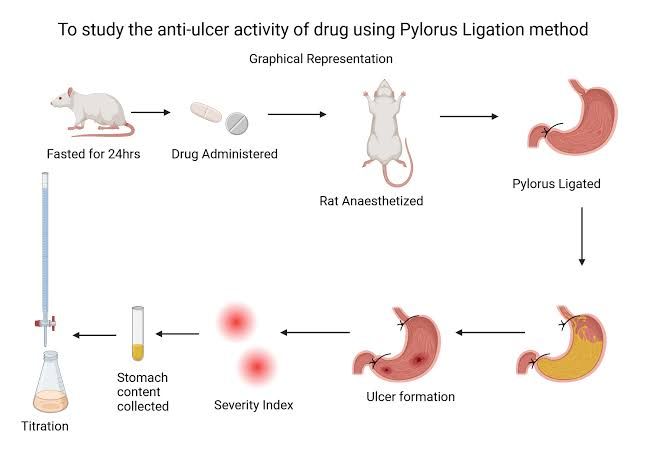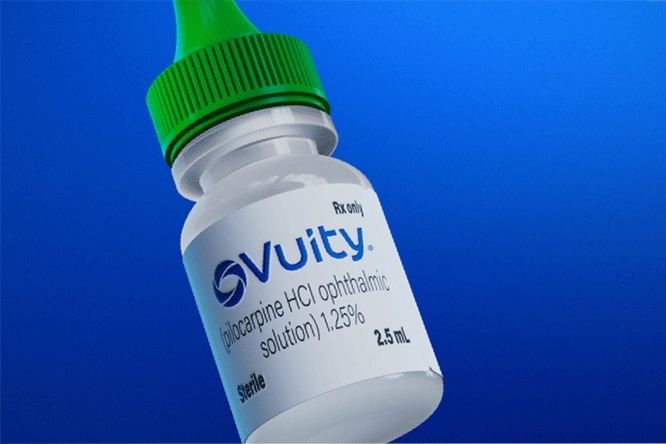
Pylorus Ligated (Shay) Rat Model
The pylorus ligation model, also known as the Shay rat model, is a widely used experimental method to study gastric ulcers. This model involves inducing ulcers by surgically ligating the pyloric end of the stomach, which leads to accumulation of gastric secretions and subsequent ulcer formation. Below are the step-by-step procedures:
1. Selection and Preparation of Animals
- Healthy adult Wistar albino rats of either sex are typically used. The animals should weigh between 160–200 g and be aged 12–16 weeks.
- Rats are housed in standard laboratory conditions with a 12-hour light/dark cycle and provided free access to food and water until fasting begins.
2. Fasting Before Experiment
- The animals are fasted for 48 hours prior to the experiment to ensure an empty stomach, but they are allowed free access to water during this period.
3. Grouping of Animals
- Rats are divided into different groups:
- Negative control group: Receives distilled water or vehicle.
- Positive control group: Receives a standard anti-ulcer drug such as ranitidine (50 mg/kg).
- Test groups: Receive varying doses of the test drug (e.g., 100 mg/kg, 200 mg/kg, or 400 mg/kg).
4. Drug Administration
- Drugs are administered orally using an oral gavage one hour before pylorus ligation.
5. Surgical Procedure for Pylorus Ligation
- The rats are anesthetized using ether or another suitable anesthetic.
- A small midline incision is made in the abdomen below the xiphoid process.
- The pyloric end of the stomach is gently lifted out and ligated with care to avoid damaging blood vessels or causing traction on surrounding tissues.
- The stomach is carefully replaced into its original position, and the abdominal wall is sutured using interrupted stitches.
6. Post-Surgical Observation Period
- After surgery, rats are allowed to recover from anesthesia and kept under observation for six hours.
7. Sacrifice and Collection of Gastric Contents
- After six hours post-ligation, rats are sacrificed using an overdose of anesthetic ether.
- The abdomen is reopened, and the stomach is dissected out at its cardiac end.
- Gastric contents are collected into a glass tube by draining them from the stomach.
8. Measurement Parameters
The following parameters are evaluated:
- Volume of Gastric Juice: Measured after centrifugation at 2000 rpm for 10 minutes.
- pH Measurement: pH is determined using a pH meter after diluting gastric juice with distilled water.
- Total Acidity: Determined by titrating gastric juice against sodium hydroxide (NaOH) solution using phenolphthalein as an indicator.
- Ulcer Index: Stomachs are opened along their greater curvature, rinsed with water, and examined under magnification for ulcer lesions:
- Scoring system: Normal coloration (0), red coloration (0.5), spot ulcers (1), hemorrhagic streaks (1.5), deep ulcers (2), perforations (3).
- Ulcer index = Total mucosal area / Ulcerated area
- Percent Inhibition: Calculated based on reduction in ulcer index compared to controls.
NSAID-Induced Ulcer Model
This model involves inducing gastric ulcers through administration of nonsteroidal anti-inflammatory drugs (NSAIDs). NSAIDs inhibit prostaglandin synthesis, which compromises mucosal defense mechanisms leading to ulcer formation.
1. Selection and Preparation of Animals
- Similar to the pylorus ligation model, healthy adult Wistar albino rats weighing between 160–200 g are used.
- Rats should be acclimatized under standard laboratory conditions before experimentation.
2. Fasting Before Experiment
- Animals are fasted for at least 24 hours before NSAID administration but have free access to water during this period.
3. Grouping of Animals
Rats are divided into groups similar to those in the pylorus ligation model:
- Negative control group: Receives vehicle only.
- Positive control group: Receives a standard anti-ulcer drug like sucralfate (100 mg/kg).
- Test groups: Receive varying doses of test drugs such as plant extracts or synthetic compounds.
4. Drug Administration
- Drugs or extracts being tested for anti-ulcer activity are administered orally one hour prior to NSAID treatment.
5. Induction of Ulcers Using NSAIDs
- A single dose of indomethacin or another NSAID is administered orally at a dose sufficient to induce ulcers (e.g., indomethacin at 20–30 mg/kg).
6. Observation Period
- After NSAID administration, animals are observed for approximately six hours while being restricted from food intake but allowed free access to water.
7. Sacrifice and Examination
- At the end of the observation period, animals are sacrificed using an overdose of anesthetic ether.
- The stomachs are removed carefully and opened along their greater curvature for examination under magnification.
8. Measurement Parameters
The following parameters help assess anti-ulcer activity:
- Ulcer Score: Lesions in the gastric mucosa are scored based on severity:
- Normal coloration (0), red coloration (0.5), spot ulcers (1), hemorrhagic streaks (1.5), deep ulcers (2), perforations (3).
- Ulcer Index: Calculated similarly as in pylorus ligation experiments.
- Percent Protection/Inhibition: Reduction in ulcer index compared with negative controls indicates protective effects.
- Additional parameters may include mucus production levels or histological analysis if required.
Conclusion
Both models provide valuable insights into potential anti-ulcer properties by evaluating key parameters such as ulcer index, total acidity, pH levels, mucus secretion, and percent inhibition/protection against induced ulcers







